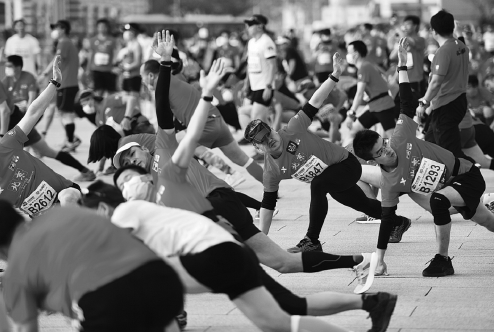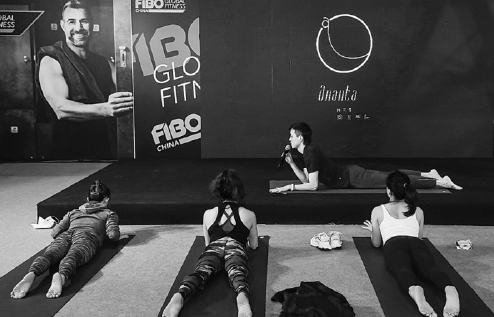Fitness finds its feet despite COVID-19 woes
Growing demand for healthy living and awareness about products increasing in nation

Though the COVID-19 epidemic crimped leisure and normal life to a large extent in China last year, it has not dampened the awareness and demand for fitness-related activities and products, judging by their steady growth.
According to the 2020 China Fitness Industry Data Report released during the 2021 FIBO China exhibition in Shanghai, there were 44,300 fitness clubs and stores across the nation by the end of last year. Though the number was down by 11.1 percent on a yearly basis, industry experts said the lower numbers were primarily due to the COVID-19.Average closure rate of fitness clubs and studios in major cities stood at 16.15 percent and 21.55 percent respectively last year.
Even though the number of physical establishments fell, the epidemic triggered a tantamount increase in the number of people participating in sports and fitness-related activities. The number of people participating in fitness-related activities rose from 68.12 million in 2019 to 70.29 million last year.
Shi Shenghai, co-founder of the Luwan Runners Club in Shanghai, said there has been a steady increase in the number of people willing to take up some form of exercise.
For the past few years, Shi and members of his club gather at the Luwan outdoor stadium in Shanghai, and split into small groups according to their capabilities, and undergo training sessions under the watchful eyes of volunteer coaches.
The club with around 2,000 members is widely known among runners for its discipline and persistence, as well as the strong performances of its longtime members. Since its establishment in 2014, the group has been training on Tuesday evenings. On warm and clear weather days, more than 100 would join the run, while on cold or rainy days dozens of die-hard runners would still show up and complete the training.
But in 2020, the teams "stopped the group training for four months, from January to May, because of the pandemic", Shi said. When the club resumed operations in June, Shi found the number of new runners was growing, and new running groups were sprouting too.
Shanghai has quite a few tracks popular with runners. For example, the ring track around Century Park in Pudong is spread over five kilometers, while the paved tracks along the Huangpu River and Suzhou Creek allow runners to enjoy great views along the way.
On average, more than 100,000 people participate in the running-related activities, said Shi. Some of the tracks have become so popular with runners that sometimes it is a bit too crowded, said Qian Kan, a 32-year-old marathon runner and triathlon athlete.
On the other hand, a growing number of veteran runners like Qian are taking up the interdisciplinary and more challenging triathlon run.
"When your knees hurt after long runs, you go swimming and when you can't make any more progress in the pool, you can turn to biking for a change," said Qian about the benefits of practicing for triathlon.
"You constantly struggle to make new breakthroughs and find that your capabilities are growing," said Qian, who is an office worker in Shanghai. "It gives you a great sense of fulfillment."
Like the industry experts, Qian also agrees that a growing number of people are taking up activities like cycling and triathlon. A number of new athletic bicycle shops have opened recently in Shanghai, selling finer and more expensive equipment, he said.
Shi from the runners' club estimates that there are more than 10,000 people who are training for triathlon in the city, and said most of them are willing to invest in fitness equipment and gadgets. For example, a starter's bicycle may cost 2,000 yuan ($308.4), but there are also some expensive bikes which can cost as much as 100,000 yuan.
Though several sports events were canceled and outdoor sports became largely impossible last year, it did not stop people eager for training to invest in home gyms. Qian, for example, bought a treadmill and an indoor spin bike, so that his training was not disrupted.
According to data released by LeadLeo Institue, the national home fitness market reached 28.15 billion yuan in 2019, with a compound annual growth rate of 35.5 percent in five years, and it is expected to reach 40.4 billion yuan this year.
Exercising at home
Due to the COVID-19 epidemic, more people are now willing to build dedicated gyms for themselves at home since it is safer and more convenient, said experts.
"In the past few years, there has been a steady growth in the number of commercial fitness equipment designed for home use and several of them are equipped with smart technologies," said Ren Hairong, managing director of Active Lifestyle's Shanghai branch.
Wang Jian, a representative of intelligent fitness brand Onelap said sales of the company's home-based spin bikes nearly doubled during the epidemic.
"As far as I know, spin bike orders have been surging since September last year," said Wang.
Meanwhile, the 2020 China Fitness Industry Data Report pointed out that sales of home fitness equipment, including treadmills, spin bikes, yoga mats and dumbbells rose sharply on e-commerce platforms, with dumbbells, hula hoops and yoga mats seeing growth rates of 500 percent, 391 percent and 332 percent respectively on a Suning's online platform for fitness products.
A few weeks after Spring Festival last year, Zhang Yun, a 36-year-old woman who lives by herself, was disappointed to note that most of the gymnasiums were still closed and she could not resume her yoga classes. However, her yoga coach invited her to an online session along with several other students, and they were able to resume the classes much like in a Zoom meeting.
"It was not so good as a real classroom, when the coach is by your side and is able to give you the required guidance and support," said Zhang. "But it felt good, that I could have some of my normal life back, and yoga helped calm my mind during the lockdown."
Along with the development of internet technology, fitness platforms such as Keep and content platforms such as Xiaohongshu (Little Red Book), Weibo and Douyin, which launched online sessions and livestreamed classes, have become important allies for the fitness industry.
The LeadLeo report said that daily downloads of fitness app Keep and Boohee increased by 478 percent and 341 percent respectively from January to February last year during the onset of the outbreak.
The number of active users of fitness apps nearly doubled during the epidemic, with Keep's active users increasing by 20 percent compared with the data before the epidemic, the report said.
The fitness passion has not subsided even though the epidemic has been brought under control.
According to consultancy iiMedia Research, the number of users of fitness-related apps in the nation exceeded 350 million by the end of last year, while the fitness app download rate increased 12 percent over the levels seen in 2019.
Zhang, for example, still spreads the yoga mat occasionally on her sitting room, although she has resumed classroom sessions with her coach. "Doing yoga at home gives me a little 'me' time, when I feel completely safe and relaxed. Besides, it is so convenient, for showering, changing and everything," she said.
Meanwhile, 60 percent of the new users intend to continue their online fitness sessions, according to the 2021 China Consumer Report released by global consulting firm McKinsey.
In addition, many offline gymnasiums have launched online platforms and video courses after their physical operation was hit by the epidemic. The 2020 China Fitness Industry Report pointed out that many gymnasiums tried to enhance customer experiences via livestreaming, video training sessions, and community guidance.
Fitness conundrum
That said, home fitness is also a double-edged sword, said Hou Xihe, a team doctor at the Shanghai University of Sport.
"It is a perfect choice during the epidemic when the prevention measures are strictly implemented and keeps the fitness enthusiast away from strangers and unfamiliar environments," said Hou, adding that it is also a time-saving and convenient choice.
"But the limited space while training at home might not be able to guarantee the air quality. In addition, the sports choices might be limited at home and there would be no proper training atmosphere. It might also affect family members or neighbors," he said.
Qian on the other hand, was more than happy to find many running mates, outdoor biking events and triathlon events this year. In the busiest weeks of April, he found up to five running events taking place over the weekend in Shanghai and nearby cities. After comparing the Qiandaohu Triathlon and the Tour of Zhoushan cycling event, he chose to participate in the latter on April 18.



Today's Top News
- Wang to meet foreign ministers of Cambodia, Thailand in Yunnan
- China's top legislature concludes standing committee session
- Thailand and Cambodia agree to temporary ceasefire
- NPC's 4th annual session slated for early March
- Civilizational links for a fairer world
- Manufacturing in China spurs global growth






























